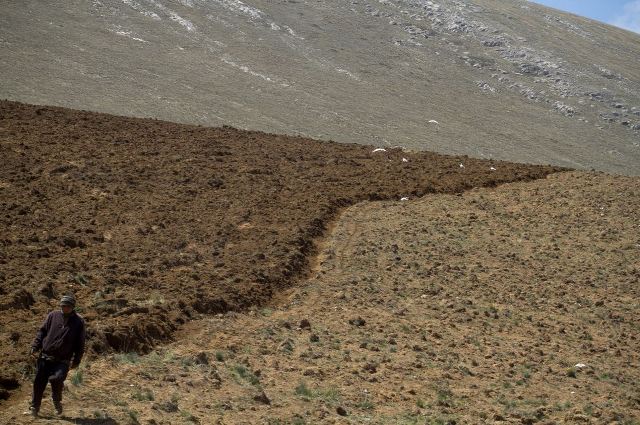This article was published by Peruvian newspaper El Comercio’s science section. It is translated to English below. See the original article.
The Andean highlands have very adverse conditions: high winds, extreme cold, low rainfall and harsh ultraviolet radiation. However, Maca (Lepidium meyenii) survives there and has been sustenance for Andean populations since ancient times.
What features of Maca withstand adverse environmental conditions?
At first glance you notice that the leaves are small with serrated edges – less surface area – which reduces water loss and exposure to solar radiation. In addition, as the weather in the highlands varies little throughout the year, the leaves do not require vernalization (prolonged periods of cold) to flourish. However, other beneficial features are not so obvious and, to learn why, we must read and decipher its genome.
That is why a group of Peruvian Chinese researchers have published the complete genome of our Maca.
Genes and altitude
The genome of Maca has about 750 Mb of information, with eight copies per cell, making them octoploides (humans are diploids with two copies of our genome per cell). Nearly half of its genome is composed of DNA sequences that can jump spontaneously from one place to another (transposable elements), and an analysis bioinformatic analysis predicts at least 51,000 gene codes.
[Download the complete genome of Maca]
Most interesting is that Maca had two gene duplication events 6.7 million years ago. This coincides with the time when the central Andes rose from 3,000 feet to 13,000 feet in altitude), which took just 5 million to 10 million years – a blink of an eye in geologic terms.
Gene duplications are key to the adaptation of a species to new environmental conditions. In this case, the genomic duplication gave Maca a wide range of evolutionary options for adapting to the harsh conditions of Peru’s central Andes.
For example, Maca has ten copies of the KNOX gene and four of the CUC2 gene insensitive to the MIR164A that gives it the lobed shape and serrated edges of the leaves. It also has genes that produce antifreeze proteins to withstand the extreme cold, and the UVR8 gene helps it tolerate extreme UV-B radiation. On the other hand, Maca lost the FRIGIDA gene responsible for vernalization in plants, although flowering occurs late by an unknown mechanism. Additionally, Chinese researchers have identified other genes that helped Maca adapt to the highlands such as the development of roots, seed dormancy and phosphorus assimilation.
Biopiracy of Maca
The samples used for this study were collected in Junin Yunnan, a province located in northwestern China. No one knows exactly how much Maca is being planted in that country, specifically near the town of Lijiang, but it is known that fresh roots left Peru illegally and there are already a number of patent applications – some already approved – in China, Poland and Korea. This is being investigated by Peru’s National Commission Against Biopiracy as it would be an illegal act.
But why so much interest in Chinese Maca? One explanation is that for a long time, Maca has been seen as a potent stimulator of sexual desire (an aphrodisiac) that can cure certain sexual dysfunctions, although there is insufficient evidence to support that claim. Apparently, the Chinese have many sexual problems because they are the main buyers of rhino horn, which they believe to have aphrodisiac properties and other nonsense like curing cancer.
The market for rhino horn is illegal and very few people – only the very rich – can access them. So Maca presents a more affordable alternative.
The problem with Maca is that it does not grow well in China because they have nowhere to grow it above 13,000 feet in elevation. Those heights exist in Yunnan Province but the climatic conditions are very different from the central Andes of Peru due to its latitude. In China, Maca roots look very different from Peruvian Maca as seen in these photos from The Maca Team:

Everything fits
The Chinese wanted to know why Maca does not grow the same in China despite being cultivated at the same elevation as in Peru. So the main motivation of this study was to learn the genetic factors associated with Maca’s altitude adaptation. The title of the article reads, “Genome of octoploid plant maca (Lepidium meyenii) illuminates genomic basis for high altitude adaptation in the central Andes.”
And now they know…
For example, since the central Andes of Peru are at a low latitude (about 10 degrees from the equator), the amount of sunlight received during the year varies between 11.5 and 12.5 hours whether it is winter or summer. Plus, there is not much difference between cold, solar radiation and so on in each season. On the other hand, the town of Lijiang is located at a latitude 25 degrees above the equator. The amount of sunlight and weather conditions vary greatly for each season. When you have these large seasonal variations, vernalization results as a key process in these plants’ development. Maca does not have that. This could affect their adaptation to the Chinese land. It is an assumption that I make based on the data.
Now that they know the genome of Maca, the Chinese will be able to specifically improve those genes that allow Maca to better adapt to their land. And not only that. They can also identify genes of interest, perhaps to produce drugs or other industrial substances.
We are guilty
It’s great that the Maca genome has been revealed. We will also be able to access and analyze this information, which will be available to download once the study is published. But researchers from other countries with higher budgets for the science will access it first and leave us behind.
Of course, I will not deny the frustration I feel in knowing how this product left the country and has become a genetic study thousands of miles away (as happened with Cat’s Claw), tossing aside all national standards and international agreements. It may be that controlling our biodiversity products is very difficult for customs to enforce, but there are countries like Brazil that do it well.
However, what frustrates me more is that we never take advantage of the great genetic diversity that we have. We don’t allocate a budget to study it. We have no national research center dedicated to studying it. We don’t generate value with our biodiversity. We have a short-term approach. If we continue down this path, other native products will meet the same fate. We do not complain.
Luckily, the CONCYTEC and FINCYT now have more in their budgets than ever before. They are funding major research projects and training professionals abroad (scholarships for masters and doctorates) with the commitment to return and apply their knowledge in Peru. Also being developed is infrastructure for scientific research, etc. But it is still not enough.
However, this strategy has already been applied by China and Brazil decades ago. We have lagged behind. Let’s not keep doing that and allocate more funds to researching and enhancing the value of our biodiversity.
Note: In the article you will find the contact numbers and emails of the researchers in case you want to ask them things related to this study, or “cyberbully” them.



I kind of had that figured out at the point where they said they could not grow it properly.
The central Andes (Pe, Bo, Ec, Co) form a specialised eco-climatic region, as you said, with the outstanding characteristics being (a) tropical and (b) very high relief. Hence, grow anything anytime as permitted by altitude, soil, sun or shade or both, etc.
Even seen cows grazing at 13,000ft around the lake at abra Conococha – Áncash.
Sadly, nothing much can be done about theft, especially if the thief is (a) bigger or (b) armed.
A British bio-agronomist has taken quinua, bred it to remove the saponins and to cook more easily, and even changed the name for us xenophobic Brits to (pronounced like) kween-oowa. Tosser. Not just the makers of fine cheap motor cars then that nick and modify.
Part of my desayuno is some spoons of kiwicha tostada (like mini pop corn) with some yog and a spoon of maca molida. I think it’s healthy but who knows. 10 or 20 thousand years of andean agriculture can’t be that wrong.
Thanks for all the information!
I like it here. No thoughts of going back..